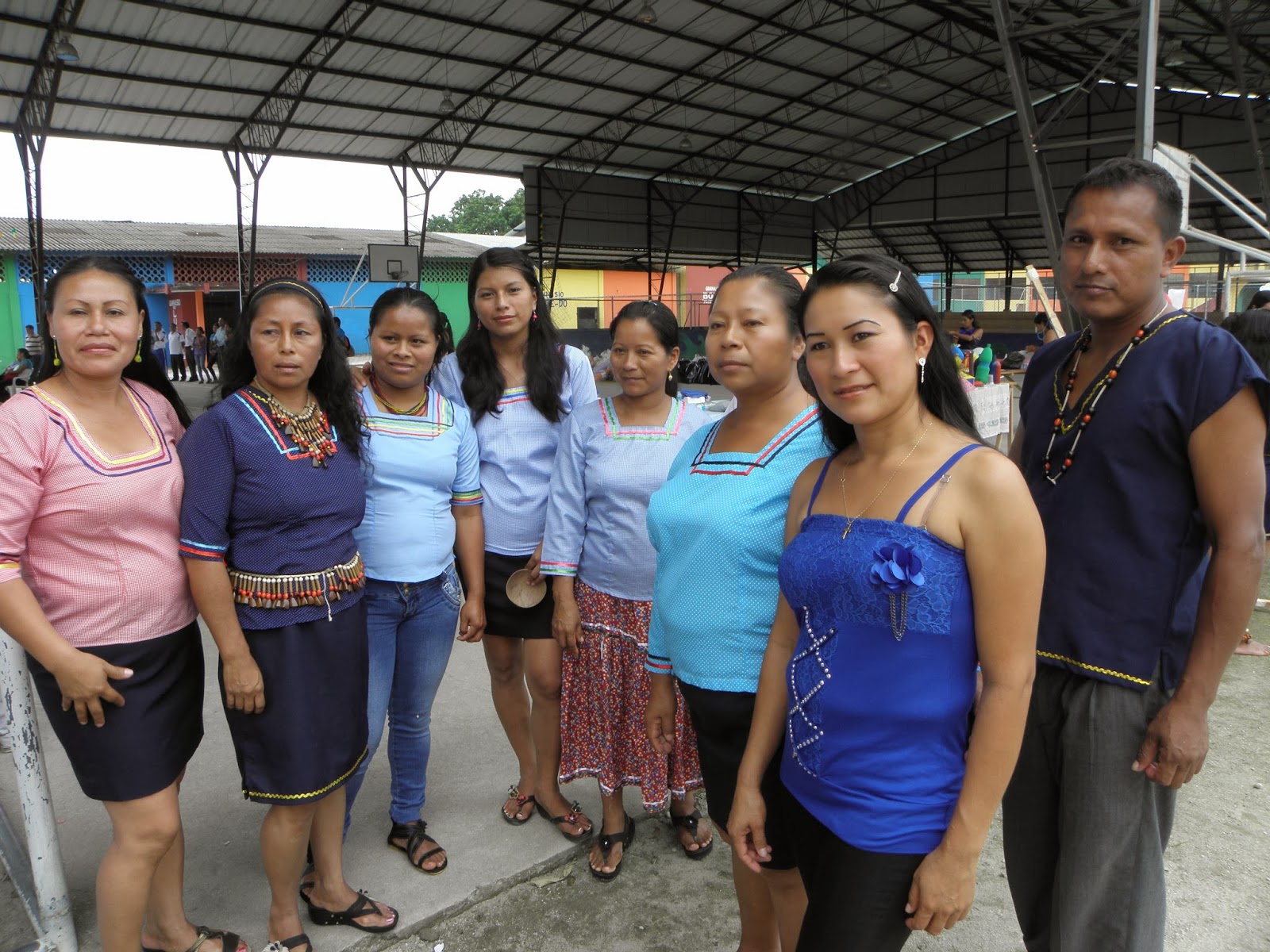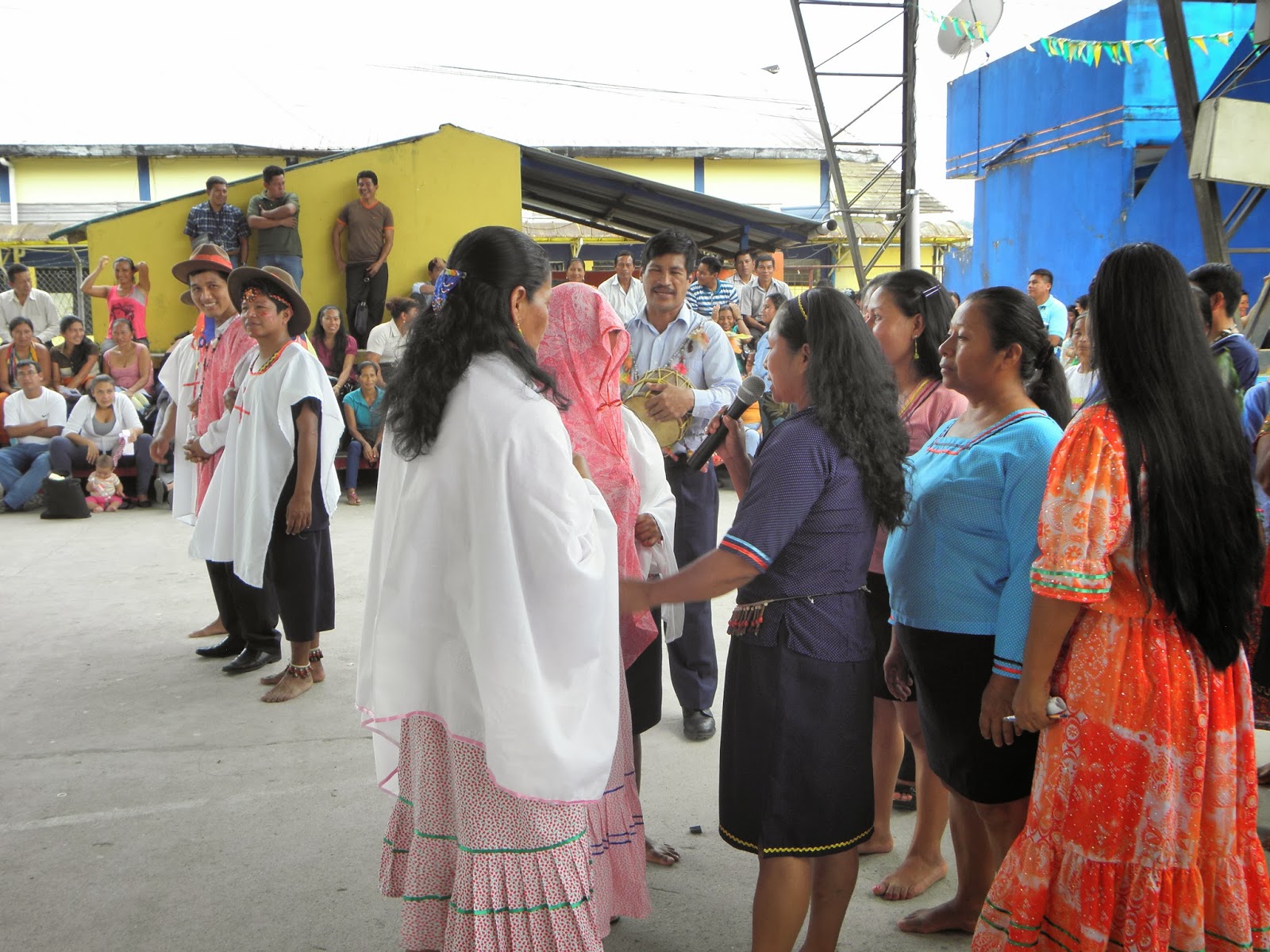Special
education teachers organized a demonstration of a traditional Amazonian Kichwa
wedding.
 |
| Amazonic Kichwa women in a mix of traditional and current fashion. |
The
wedding ceremony is an eclectic mix of original traditions and beliefs.
Added
with some new ones brought by Catholics and mestizos, called Colonos by the
Kichwas.
 |
| (Pretended) Bride-to-be's party. Second on the left, brides godmother. First on the right, the brides father, the bride and her mother. |
Kichwas
have been losing both their traditions and language.
They
feel very worried about the cultural devaluation happening, especially amongst
the younger generations.
The
traditional marriage ceremony can last for days and is considered the
culmination of the Kichwa culture.
Kichwa women are traditionally very sheltered and before they were even
considered a possession, in the worst case scenario.
Teenage girls could not talk with the opposite sex members.
Even today, it is common in
the Kichwa communities, inside the jungle, for a father to force a daughter to
marry if he suspects her of having a relationship with someone from the oposite
sex.
This relationship can
consist of a neigbor seeing the girl talking with a boy from the same village under her
house.
Like what happened to my
friend's fourteen year old cousing.
She was forced to marry a
sixteen year old boy from her village.
According to my friend she
was just talking with the boy because he came to look for her father and he was
not at home.
But a neighbor saw her and
talking began, and her father felt that his pride was hurt.
So, she had to be wed.
It seems that she was not so unhappy to wed the boy, so maybe there was something going on with the two of them.
But my friend felt very
sorry that she had to leave the school at so young age and take responsability
of running a household instead.
Closer to the cities and
towns the traditions have changed.
But people still get
married young.
Usually the couple lives
for few years together, gets maybe a child or two, and if they are sure.
Then they
get married.
My friend, Celia, is an
Amazonian Kichwa woman from an indigenous community deep in the jungle in the
Orellana province.
Her Kichwa is a little
different from the language spoken here in Napo province.
Celia's traditions vary also
and in many ways the people in her home community have been able to maintain
their traditions longer than the Kichwas from Napo.
She invited me to my first
Kichwa wedding.
 |
| In an Amazonian Kichwa wedding people literally drink buckets full of chicha. Here my father and mother enjoy lumu aswa that the special education teacher's serve them. |
Her husband's cousin had
asked them to be his godparents.
This was a huge honor but a
huge expense also.
Because they had to pay for
the wedding, the food, the entertainment, everything.
 |
| The chicha bowl or cup needs to be drink until it's empty. Or like one of the teacher's told me when she gave me the cup, until you can only see the peanuts. It is a very bad manner to leave chicha. |
She wanted the ceremony to
be as authentic as possible.
So her father and brothers
hunted and smoked wild animals from the jungle for weeks before the actual
party.
Since Celia's parents live
far away and it's hard for them to come to Tena, she wanted me to be there as
representation of her family.
It was such an honor to
attend the wedding as a family member and be able to be part of the actual ceremony and traditions.
It also meant that I had to
get a big and expensive gift, because in a Kichwa wedding, gifts need to be
big.
The wedding I attended in
the jungle started with a Catholic mass where the groom was baptized and
christened.
Following a traditional
party in a jungle setting until the next day.
It was an interesting opportunity
to be able to see the ceremony again and very humbling to be explained so
thoroughly by the special education teachers.
 |
| The bride's hair is decorated with shiny hair pins. This is traditionally done by groom's godmother. Amazonian Kichwa woman's hair is sacred and the only man who can touch it is her husband. |
The demonstration and the
actual wedding were very similar.
The real wedding was held
deep in the jungle but the demonstration was held in Tena where anyone could
attend it.
A lot of people came to see
it and the audience, mostly Kichwas themselves, enjoyed the cultural jokes immensely.
The bride's mother, Germania,
told me that she decided that if she was going to give her daughter away, even
if it was pretense, she was going to do it right.
And that she did.
 |
| Bride's godmother advices her on how to be a good wife. The ceremony master sings the ceremony in Kichwa simultaneously directing and explaining what is happening to the participants and crowd. |
She advised the groom,
exhorted him to take care of her daughter and cried and shouted to him in front
of all the audience.
When it was time to clothe
her daughter and advise her, as is the tradition in Kichwa weddings, she
started to cry harder and made everyone else cry also.
She told her daughter to
behave, to be a good wife, to obey her husband, and to make sure his husband
and her household never goes without chicha.
Just like her real mother
would.
 |
| The women and men dance in turns straight ahead and the back. Occationally they change places following the ceremony master's advice. Or the hat's are passed from one group to the other. |
When the bride has been
clothed, it is the time for the dance.
The ceremony master's voice
combines with the drum’s slow and even beat to create a hypnotic rhythm.
 |
| The bride's mother and the family join the dance. |
The two groups slowly
shuffle back and forth.
In a real wedding the
dancing can take hours, or even days.
Little by little, by the
ceremony master's advice, people are added to the groups.
 |
| Groom's godmother and her companion take the bride to the table. The groom is brought by his godfather and his companion. |
Bride's mother and
godmother join her.
Bride's father and groom's
father join the groom's group.
Until the whole wedding
assembly is dancing.
 |
| Groom's godmother lifts the bride's veil. |
When the dancing finally ends, it is time to take the bride and groom to the table.
They are both seated and declared a man and a wife.
 |
| Family members's bring their gifts and more advice. Afterwards the new husband and wife thank the people publicly for their advice and gifts. |
After this bride's veil is lifted and the guests start to bring their gifts.
The gifts are usually given
unwrapped so that everyone can see what this or that person has brought.
Like I said before, in an
Amazonian Kichwa wedding, the bigger the gift, the better, at least for the
giver.
Usually the newlyweds get
their house furnished with everything they get in the wedding.
 |
|
A
mattress is a very necessary and hilarious gift. It brings in the mind what
will happen on it. And Kichwa humor is a very earthy one.
|
When the gifts are given, it is time for the wedding banquet to begin.
The wachimans, or wedding helper cover the floor with banana leaves and the food is then set on them.
 |
| Bride's family eating a traditional wedding banquet from the banana leaves. |
The bride's family sits around the leaves and eat the food together.
Bride's mother and father are the most important guests at the wedding and they eat first and the best food in the biggest portions.
 |
| This was not a real wedding but even though the food is such an integral part of Kichwa hospitality that we were offered a soup made of smoked fish with banana and yucca. |
They are giving away their daughter and groom's family should feel thankful and honored for it.
The other guests get their food after them.
When the wedding banquet is over it is time for the real party to begin.
The wedding cake is eaten at five o'clock in the morning, after a whole night of dancing and celebrating.
 |
| Uchu, or different kind of chili peppers, is a very important part of Amazonian cuisine, culture and traditions. |


















Thanks for showing photos of the wedding and discussing all the different customs and traditions that are part of it. I enjoyed reading this very much.
ReplyDeleteThis was very cool to read and see.. The traditions of them are very different then what we see here in the US.. It is truly amazing that they try and keep to as much tradition as possible.
ReplyDeleteThat is very interesting. I like looking at the photos.
ReplyDeleteGreat photos and thanks for sharing that was neat to see.
ReplyDeleteWow, great photos. I love learning different cultures and traditions.
ReplyDeleteMichelle F.
A whole different world in Ecuador. The bride does look happy though.
ReplyDeleteWhat an amazing thing for the teachers to put on. I would love to witness an authentic ceremony.
ReplyDeleteI love learning about different cultures! So different than how we make weddings here in the states but simplicity is under rated!
ReplyDeleteYou always have such amazing photos and cultural insights! Thanks for sharing :)
ReplyDeleteGreat Tradition Beautiful Culture!
ReplyDeleteThis comment has been removed by a blog administrator.
ReplyDeleteI couldn't imagine having to be married to the first boy I'd ever talked to. The food looks good, aside from all the banana. I'm allergic so would I be rude if I was there and they offered it to me but I could not have it?
ReplyDeleteSo many differences. It's interesting to read about them. I think the honor of being a godparent is a huge difference from the way we view it in the US. Are those selected happy to pay for the wedding and all that goes with it in its entirety? Or does it cause a burden? I am just curious. :)
ReplyDeleteUsually it's both. They are happy and honored, after all you can deny and say that you don't have the money or the means or some other reason. It can cause trouble between the families in some cases, but it is possible. On the other hand, people aren't saving consentious, they are glad to spend the money and take debts and then struggle with them.
DeleteThat's a very interesting tradition, really nice to learn about other cultures. We've got a lots of traditions when it comes to weddings but all they have in common with the Ecuadorian one are food, drinks and dancing :)
ReplyDeleteWhat great traditions and such beautiful pictures. Thanks for sharing.
ReplyDeleteGreat Pictures, love the cultural details and the amazing rich traditions!
ReplyDeleteIts so interesting to see traditions in other cultures. I would have never known and your pictures are beautiful!
ReplyDeleteBad manners to not drink all the Chicha - there is so much to eat and drink here!
ReplyDelete